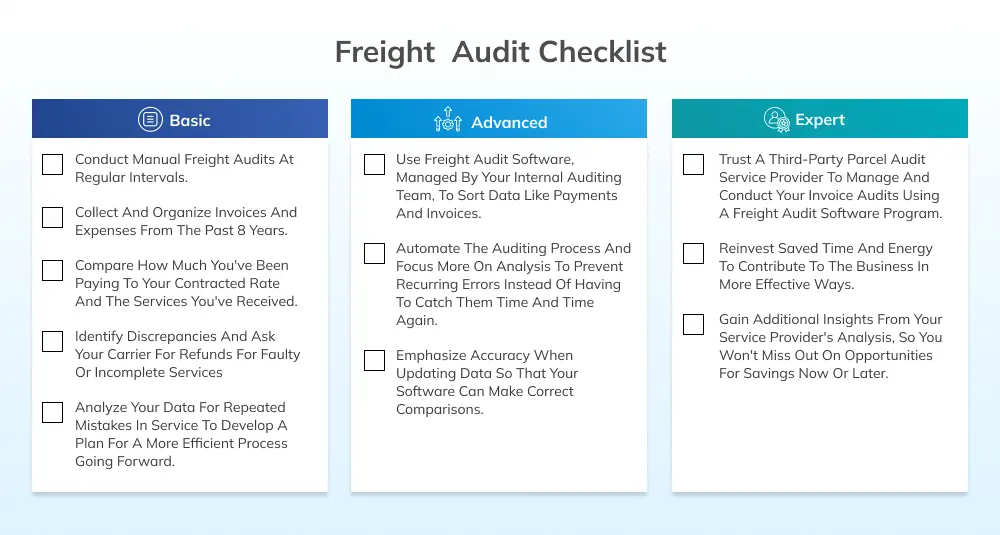
Content
Invoice complexity is at an all-time high, while freight prices continue to rise. According to GlobeNewswire (2024), the worldwide logistics market is expected to reach $21.91 trillion by 2033. This means that even a 3–5% billing error rate can result in your business losing millions of dollars.
According to a study by The Economist Intelligence Unit (EIU), more than 60% of logistics teams continue to manually review invoices or use samples for verification.
The outcome? Underbilling, unexpected accessories, and duplicate payments all get lost in the system. Freight audits are now a strategic requirement rather than a choice.
Staying updated on every detail, rate fluctuation, industry amendment, and technology innovation is crucial for an effective freight audit process. If you want to stay present and lead in the market, constant knowledge is not optional — it’s essential.
Irini Orfanoudaki, B2B Export Consultant
This blog provides a 10-step freight audit checklist to minimise freight expenditures, accurately match invoices to contract terms, and promptly identify any discrepancies.
What Is a Freight Audit Checklist
A freight audit checklist is a structured framework to examine, verify, and reconcile freight invoices against shipping contracts, rates, and shipment data.
Logistics and finance teams utilize it as a detailed manual to ensure billing accuracy, identify overcharges, and maintain contractual compliance.
By maintaining a freight audit checklist, you can ensure that nothing is overlooked, from rate matching and accessory fees to identifying exceptions and resolving disputes.
Benefits include increased visibility and control over freight expenditures, automated invoice processing, and cost reductions through the identification of errors.
Why Freight Audits Are Essential to Cost Control
It becomes increasingly challenging to monitor and manage freight expenses as logistics networks become more intricate and dynamic. There’s even financial leakage due to changing price patterns, diverse carrier contracts, and hybrid shipment methods.
Unchecked freight expenses have the potential to rapidly become a financial burden as logistics networks expand in size and complexity.
According to Gartner’s Market Guide, contemporary freight audit and payment systems utilize analytics and automation to minimize errors, maximize rate compliance, and expedite processes.
Businesses risk hidden fees, inflated landed costs, and margin erosion if they don’t have a methodical, data-driven freight audit checklist procedure. Thus, freight auditing protects the financial stability of logistics by acting as a strategic and remedial tool.
The Typical 4 Freight Audit Errors That Cost You Money
Manual freight audits frequently overlook significant mistakes.
SupplyChainBrain research states that up to 10% of freight bills contain errors. The majority work in the carrier’s favor. These typically include unauthorized accessorial fees, duplicate charges, and incorrect rates. Here’s an in-depth look:
1. Sample Audits Instead of Thorough Invoice Reviews
Relying on random sampling instead of reviewing every invoice is a significant mistake in freight auditing. Only a small portion of billing discrepancies are captured by sampling, which overlooks hidden patterns and recurring overcharges.
Why it occurs: Teams are forced to audit selectively due to time or resource restrictions.
To avoid this, use automatic full-invoice audits to find irregularities in every shipment. According to studies, 20–25% of freight invoices have inaccuracies; hence, thorough audits are crucial.
2. Ignoring Contractual and Accessorial Fees
Ignored ancillary expenses, such as fuel surcharges, liftgate fees, detention, and redelivery, are frequently the cause of billing errors. Often, these are misused or charged without cause.
The reason for this is that tariff conditions and contracts aren’t always mentioned while billing.
Avoidance: Disputes are decreased by automated rate engines that compare invoices to contracts and accessory terms. Accessorial fees account for 52% of billing errors in multimodal shipments and 54% of billing problems in maritime freight, according to Global Growth Insights.
Unnecessary accessories can account for 36% of the total shipping cost, according to Sifted.
3. Insufficient Uniformity Among Carriers
Because freight bills might take many different forms, standardizing audits is challenging. Inconsistent nomenclature, units of measurement, and fields lead to misunderstandings and mistakes in data entry.
The reason behind this is that carriers employ proprietary billing systems that lack standardized formatting.
Use digital audit tools that standardize and map invoice fields among carriers as a preventative measure. Trax points out that inconsistent invoices directly cause expensive billing errors.
4. Data from Fragmented Invoices
Accurate, real-time auditing is practically difficult when contracts, invoices, and delivery confirmations are dispersed across several systems (ERP, TMS, carrier interfaces).
Why it occurs: Systems that are siloed make it impossible to see the freight lifecycle holistically.
To avoid, utilize freight audit software to centralize data by integrating all sources. One of the biggest obstacles to prompt, error-free reconciliation, as SupplyChainBrain emphasizes, is fragmented invoice data.
Top 10-Step Freight Audit Checklist

1. Aggregate & Concentrate Invoices
Consolidating invoices that are frequently dispersed over email, TMS, ERP systems, and carrier portals is an essential first step in your freight audit checklist. Vendor conflicts, overpayments, delayed recovery, and fragmented audits are all consequences of siloed data.
Freight auditing now requires close coordination with IT and is no longer solely a finance function. Real-time validation, AI-powered invoice matching, duplication identification, and compliance-ready workflows that link ERP and TMS systems are all necessary for modern audits. By increasing accuracy, compliance, and scalability, this cohesive strategy turns freight audits from reactive to strategic.
As an example, SAP cites Coca-Cola HBC’s integration of Systems, Applications & Products in Data Processing, SAP S/4HANA, with a real-time transport visibility platform available to more than 100 carriers, which improves delivery efficiency and lowers expenses by centralizing shipment and invoicing data.
Best practice:
- Create a live data pipeline that consolidates all shipments, BOLs, PODs, invoices, and contracts into a single, audit-ready repository.
- Use EDI, API, or TMS interfaces to enable seamless integration and data flow.
2. Align Contracts and Documentation
Your freight audit checklist needs to contain version-controlled, readily available contract terms, tariffs, SLAs, and fuel surcharge schedules to properly validate freight bills. Reduced recovery, postponed disputes, and invoice misvalidation might result from outdated or absent paperwork.
According to the 2020 Infosys BPM Third-Party Logistics Study, 94% of shippers believe that consolidated data, including contracts, and strong IT capabilities are essential for logistics performance.
A well-known 3PL made real-time access between teams possible by integrating its contracts and SLAs into a centralized audit system. This significantly improved audit efficiency and carrier relationship fidelity by reducing dispute resolution time by 50%.
Best Practice:
- Keep a version-controlled document library for each carrier that includes SLAs, rate sheets, contracts, and fuel surcharge schedules.
- Set up automated notifications for fuel updates, contract renewals, and rate changes.
3. Invoice Validation
Invoice validation is among the most crucial elements of any freight audit checklist. It involves more than just verifying totals; it requires precise cargo parameters such as weight, dimensions (DIM), freight class, zone, and service level.
In parcel and LTL shipments, errors here are often the cause of overcharging.
By incorporating shipment data checks into its freight audit checklist procedure, a logistics company in the UK, which partnered with Invensis, was able to reduce the time required to verify invoices by 80%. In addition to increasing payment accuracy, this allowed the team to concentrate on high-value work.
Also, errors in invoice validation were causing operational inefficiencies for a major U.S. factoring company. A customized validation procedure created by Invensis led to a 95% decrease in invoice errors, greatly enhancing processing precision and cash flow stability.
Best Practice:
- Create automatic rules to compare shipment records with each invoice
- Weight & DIM: Verify recorded dimensions or scale tickets against billed values.
- Ensure that the freight class aligns with the NMFC codes.
- Zone & Service Level: Verify the agreed-upon service and the accurate origin-destination.
- For manual review, mark invoices that differ by more than 5%.
To expedite verification and reduce errors, integrate WMS/TMS feeds so that the audit system can compare actual shipping details in real-time.
4. Rate Matching
To identify differences between contracted rates and billed costs, automatic rate matching must be a part of your freight audit checklist process.
Manual checks are slow and prone to errors, particularly when fuel prices and taxes fluctuate regularly. By automating this process, billing accuracy is ensured and revenue leakage is minimized.
An Australian consultant benchmarked freight cost scenarios and digitized rate cards using the Dyspach technology. In addition to standardizing rate validation across the board, they identified invoicing discrepancies of 10–20%, resulting in approximately 20% savings across procurement segments.
Best Practices:
- Add complete rate libraries to your audit system, including tariffs, accessories, and fuel regulations.
- Establish ±2–5% variance criteria to initiate invoice holds.
- Automate four-way matching: PO ↔ Contract ↔ Shipment ↔ Invoice
- Maintain rate cards in a current and version-controlled state.
5. Accessorial Scrutiny
If left unchecked, accessory charges, fees for services such as liftgate, detention, inside delivery, limited-access destinations, or drayage, can subtly increase freight prices by 10% to 20% or more.
According to the Mastio & Company LTL Benchmarking Study, these expenses are a significant factor in choosing a carrier. Additionally, these line items are susceptible to billing errors and hidden costs due to the complexity of carriers’ regulations and evolving fee structures.
Best Practices:
- Establish a policy for accessories: To direct audits, preapprove the permitted fees according to the carrier contract.
- Keep an eye on trends: To negotiate more intelligent contracts, examine accessorial frequency by carrier or lane.
6. Detect Exceptions
Exceptions are early indicators of more serious process problems or even fraud, such as duplicate bills, non-contracted carriers, or unexpected fees. Real-time anomaly detection should be on your freight audit checklist to identify these issues before they escalate into more serious problems.
Hannah Testani of Intelligent Audit is featured on McKinsey, explaining how they utilize machine learning to audit invoices almost instantly:
Within two hours of receipt of any electronic invoice, we complete the freight audit and work with the carriers preemptively, before the invoice is paid, to achieve a resolution on any disputed amounts.
Hannah Testani of Intelligent Audit
Best Practices:
- To identify invoice irregularities such as duplication, non-contracted carriers, or price differences, use machine learning (ML) or rules-based systems.
- Automate exception workflows: log resolution stages for better oversight, elevate for review, and hold suspicious bills for further review.
7. File Disputes & Track Claims
A timely and well-documented dispute process significantly increases recovery rates and reduces the time it takes to resolve disputes. Credibility is diminished and credits are sometimes lost when arguments are postponed or insufficient proof is submitted.
To guarantee timely claims and optimize reimbursement, your freight audit checklist should automate recovery tracking and dispute documentation.
Best Practices:
- Simplify the claim submission process by automatically combining contracts, BOLs, and invoices into a single package for carriers.
- Assess success rates: To improve the procedure, monitor dispute outcomes, aging, and recovery percentage.
8. Verifying Freight Charges
Maintaining cost management and billing transparency requires careful verification of freight charges, including base rates, surcharges, weights, and ensuring accurate addresses. Your bottom line might be significantly impacted by even minor inconsistencies, such as duplicate payments or incorrect weight calculations.
During a six-month audit, Scoular, a significant U.S. grain and feed exporter, found over $1.95 million in duplicate ocean freight invoices, according to the Journal of Commerce.
Additionally, an extra $3.7 million in invoicing irregularities were detected by their real-time detection technology, demonstrating the potent return on investment of thorough invoice verification.
Best Practices:
- Automate contract-to-invoice matching to confirm delivery information, weights, base rates, and accessory fees.
- Before payments are made, use exception detection technologies to identify duplicates or mismatches, recover overpayments and strengthen freight expenditure controls.
9. Invoice Approval and Payment
The final step in the freight audit checklist is to approve and release clean invoices for payment once the discrepancies have been resolved. Cash flow and carrier relationships are impacted by manual approval cycles, which are prone to bottlenecks and late fees.
Using an AI-driven invoice intelligence solution, a mid-sized software reseller was highlighted in Forbes’ article “The Promise and Pitfalls of Invoice Intelligence.” They essentially eliminated the requirement for manual tolerance checks and reduced invoice processing time from days to less than 24 hours by automating validation and approval operations.
Best practices:
- To approve invoices that match audited data (rates, conditions, and accessories) promptly, set up automated rules to streamline the process.
- To prevent aging, escalate flagged entries to procurement or finance for human assessment within a specified SLA.
10. Analyze Audit Outcomes & Generate Actionable Reports
The purpose of freight audits should be to inform strategy, not just to ensure payment. Finding recurrent overcharges, non-compliant carriers, and areas for cost savings is made easier by analysing audit results.
According to Gartner’s Market Guide for Freight Audit & Payment Providers, shippers can now leverage audit data for enhanced spend visibility, effective exception management, and informed strategic decision-making, as FAP platforms incorporate advanced analytics and business intelligence.
Best practices:
- Create KPI dashboards that monitor carrier compliance, dispute cycle time, recovery %, and error rates.
- To promote data-driven carrier negotiations, include audit insights into monthly operations and financial evaluations.
11. Maintain Records & Ensure Regulatory Compliance
To wind up your freight audit checklist, logistics records, including invoices, contracts, SLAs, and payment logs, must be safely and traceably preserved for freight audits to leave a full trail.
Public firms in the United States are required to adhere to SOX Section 404, which requires robust internal controls and audit logs.
U.S. Customs & Border Protection (CBP) mandates that importers and carriers keep records, such as invoices and shipping documents, for a minimum of two years while engaging in international trade.
Best practices:
- Documents should be kept in a safe, permission-based digital system with time-stamped audit trails and version control.
- Ensure accessibility and searchability by aligning retention standards with CBP recordkeeping (minimum 2 years) and SOX (usually 7 years).
5 Key KPIs to Monitor
To guarantee ongoing improvement, your freight audit checklist should additionally monitor KPIs as follows:
Why Outsource Your Freight Auditing Services?
In-house freight audit management can waste time, increase expenses (up to $11 per invoice), and put you at risk for noncompliance. Hiring a logistics specialist, such as Invensis Technologies, to audit your freight audit checklist enhances accuracy, speed, and visibility while significantly reducing operating expenses.
Invensis offers you end-to-end freight audit support by combining AI-powered technologies, skilled auditors, and industry-best compliance workflows.
We have over 20 years of experience in worldwide logistics. This translates into fewer billing errors, quicker dispute resolution, and more time for informed decisions regarding supply chain strategy.
A managed freight audit checklist helps coordinate cost control with strategic planning, whether you’re expanding operations or reducing spending.
So, get savings, control, and speed without the overhead. Contact us now to enhance your freight audit process.
Conclusion
From a back-office task, freight auditing has developed into a strategic tool for logistics intelligence, cost control, and compliance.
Businesses can reduce waste, enforce carrier adherence, and uncover hidden value within their logistics budget by implementing a 10-step freight audit checklist.
They can maintain their agility, accuracy, and data-drivenness by outsourcing freight audit services to a reliable partner like Invensis Technologies. This also opens the door to environmentally friendly, artificial intelligence-powered, and digitally secure audit workflows.
FAQs
Discover Our Full Range of Services
Click HereExplore the Industries We Serve
Click HereBlog Category
Related Articles

Find the leading accounting firms in Singapore trusted by businesses for audit, tax, and advisory services.
November 6, 2025
|

Explore the leading accounting firms in South Africa providing expert audit, tax, cloud accounting, and payroll services. Learn about their key features and unique offerings.
November 6, 2025
|

Explore what project accounting is, how it works, and why it’s essential for businesses. Understand key principles, revenue recognition methods, and best practices to improve your knowledge.
October 7, 2025
|
Services We Provide
Industries We Serve







.webp)